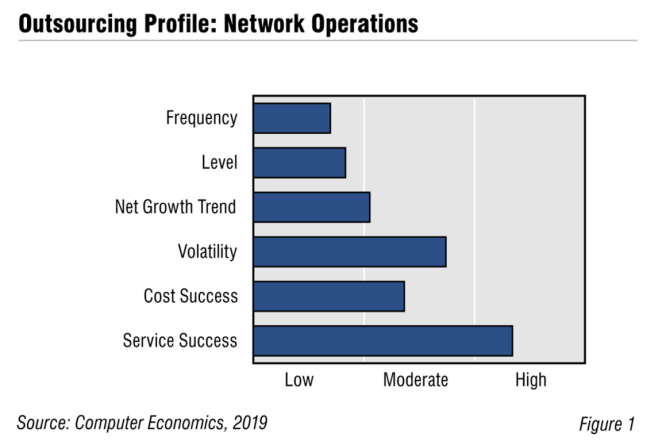Network operations outsourcings is still one of the least-frequently outsourced functions that we track in our annual IT Outsourcing Statistics study, and it doesn’t look like this will change anytime soon. Good customer experience and decent success in controlling costs, for the past several years, has not lead to any increase in outsourcing this function.
As shown in Figure 1 from our full report, Network Operations Outsourcing Trends and Customer Experience, the net growth trend—the percentage of organizations increasing the amount of work they outsource during the previous year minus the percentage decreasing the amount of work outsourced—is on the low side of moderate. The volatility, the measure of how many organizations are changing the amount of work outsourced, either up or down, is also moderate.
Other data from the figure shows that frequency (the percentage of respondents that outsource network operations) and the level (the percentage of work that is being outsourced) are both low. In terms of customer experience, service success (the percentage of those outsourcing who say the service is the same or better than if they had kept the function in-house) is high. Cost success (the percentage of those outsourcing who say the cost is the same or less than performing the service in-house) is moderate.

About 94% of IT organizations in our survey that outsource network operations say the service is the same as or better than when performing the function in-house. And networks are becoming more complicated as IT organizations invest in more use of video, unified communications, software as a service, and public cloud infrastructure. Software-defined networking and security issues in the network also put pressure on companies to find new and varied skills to maintain their networks. As networks become more complicated, it would usually be more attractive to outsource some or all of network operations in order to access the latest skills. So why are companies not outsourcing network operations?
“The same factors that are making networks more complicated also make the network function more vital to the organization,” said David Wagner, vice president, research, for Computer Economics of Irvine, Calif. “Reliance on cloud and SaaS and an increasingly mobile workforce means downtime in the network can grind the whole organization to a halt. Some organizations may simply feel that their network is too mission-critical to outsource.”
We still believe that the positive service success may eventually lead more companies to try outsourcing their network operations in the long run. However, with a relatively strong economy and fairly generous IT budgets, companies are currently not inclined to make a change.
To help IT executives understand their options, the full report examines adoption trends in the outsourcing of network operations. We report on the percentage of organizations outsourcing network operations (frequency), the average amount of work outsourced (level), and the change in the amount of work being outsourced (net growth trend and volatility). We also present the cost- and service-success ratings, which provide insight into the potential risks and rewards IT organizations take in turning to service providers. We show how these trends differ by organization size and sector and provide recommendations for engaging with network operations service providers.
This Research Byte is a brief overview of our report on this subject, Network Operations Outsourcing Trends and Customer Experience. The full report is available at no charge for Avasant Research subscribers, or it may be purchased by non-subscribers directly from our website (click for pricing).

